One of the most popular activities in Delaware is fishing. With opportunities all year long, locals choose from ocean beaches, special access piers, and other bodies of water to try their luck. As fun as these expeditions are, some people set out for a new record whenever they cast their line. Let’s take a look at the largest fish ever caught in Delaware, according to the official state website.
16 Largest Local Fish Ever Caught in Delaware
Here are the largest fish caught in Delaware’s freshwater lakes, rivers, and other bodies of water.
Largest Striped Bass: 13.8 lbs

Using fresh bait is one of the easiest ways to catch a striped bass.
©slowmotiongli/Shutterstock.com
The striped bass, also known as the striper or linesider, primarily lives on the Atlantic coast. As an excellent sport fish, striped bass lives largely outside the natural habitat they ordinarily choose. These sizeable fish are challenging, so eels, clams, and other live bait are necessary for any angling trip.
Earl Blevins set the record for Delaware’s largest striped bass in 1990 at almost 14 lbs. The world record came out of Connecticut at 81 lbs.
Largest Largemouth Bass: 11.1 lbs
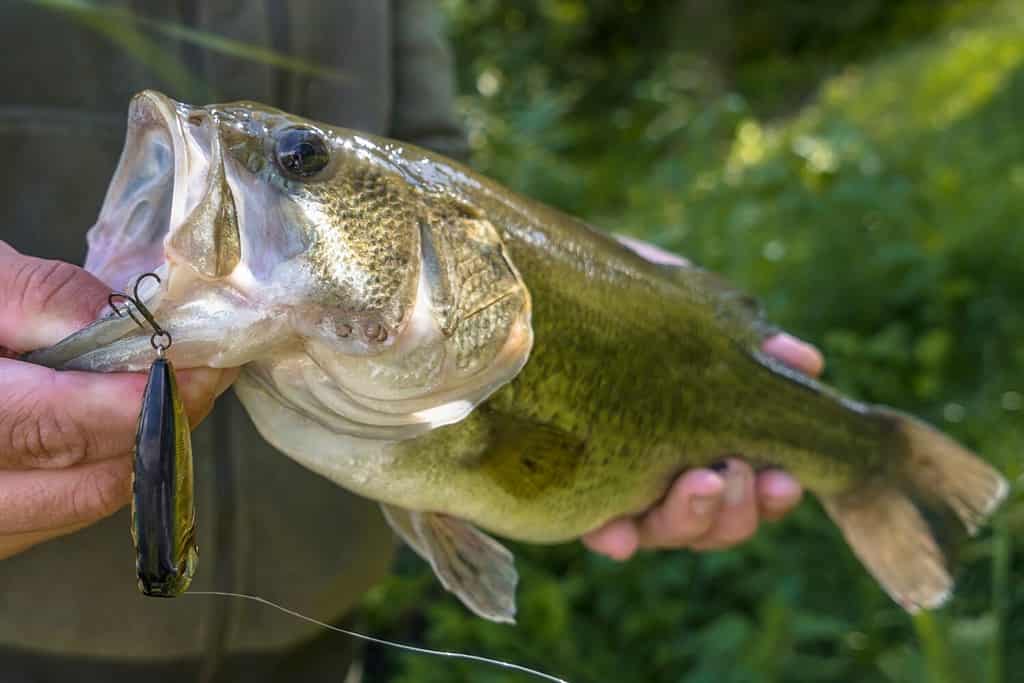
The largemouth bass has a carnivorous diet, so live bait offers the best odds of catching them.
©FedBul/Shutterstock.com
Found exclusively in freshwater, the largemouth bass has many different names, depending on the region. Some of those names include the Florida largemouth, green bass, and Potter’s fish. They are the official state fish of Georgia and Mississippi. However, they are an invasive species, which means native species die out quicker when they live.
The largest largemouth bass on record weighed over 40 lbs. However, Delaware’s local record is 11 lbs.
Largest Smallmouth Bass: 4.9 lbs

This freshwater smallmouth bass is part of the sunfish family.
©iStock.com/RLSPHOTO
The smallmouth bass primarily spreads across the country through stocking rather than reproducing and subsequent distribution. It presently lives in cooler waters in Canada and the United States. It also goes by brownie, bronze bass, and bareback bass. Males are about half the size of females, living primarily in moving water.
While Delaware’s largest catch was barely 5 lbs, the largest recorded smallmouth bass ever was 12 lbs.
Largest Bluegill: 2.6 lbs
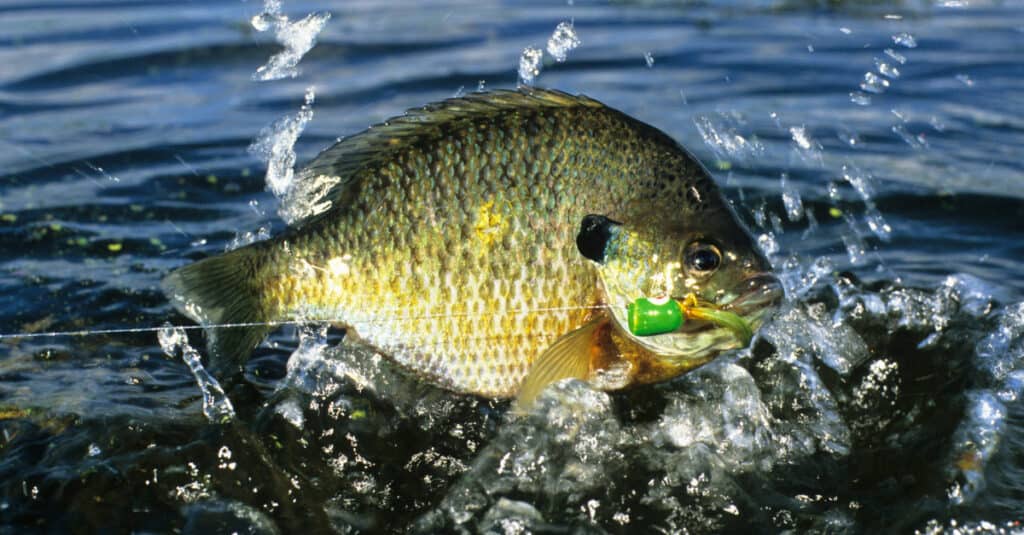
Bluegill fish prefer streams, rivers, lakes, ponds, and wetlands, thriving on the eastern coast.
©iStock.com/stammphoto
Bluegills only weigh a few pounds at the most, but their distinct coloring makes them easy to spot. They have blue and purple on their face, while their sides are olive green. Their belly is often orange or yellow. This omnivorous species eats anything and everything but prefers insects and small bait fish. They are towards the bottom of the food chain, providing food for northern pike, walleye, and trout.
In 1998, Arnold Harmon caught the largest bluegill in Delaware’s history, weighing 2.6 lbs.
Largest Carp: 45 lbs
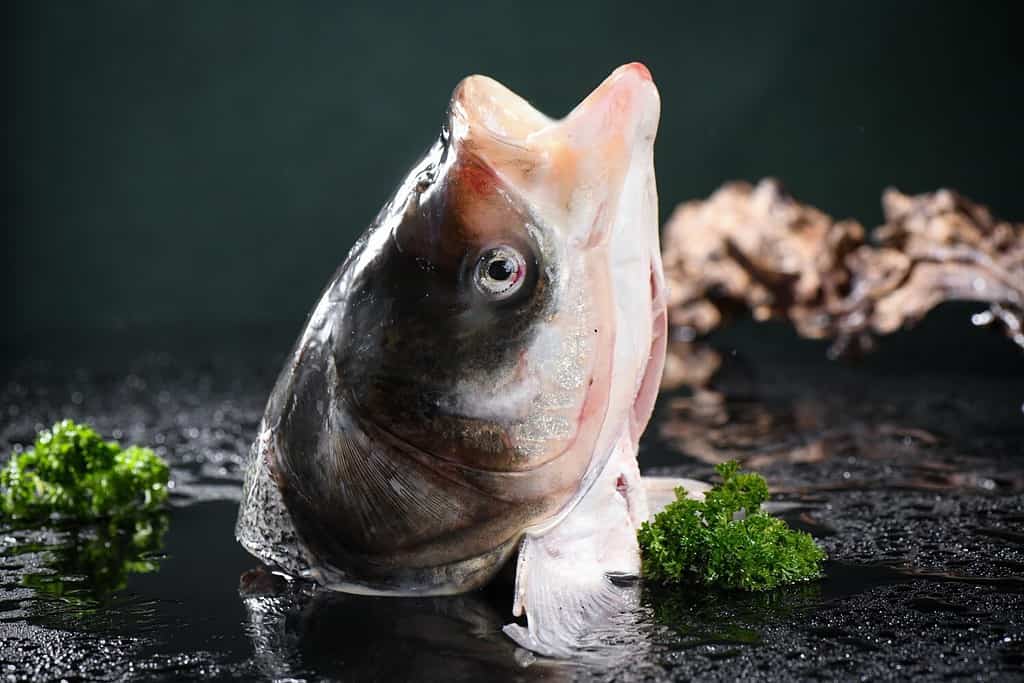
Many freshwater fish fall under the term “carp,” though they are an invasive species in most of the United States.
©xiaoxiao9119/Shutterstock.com
Carp aren’t often fished for food. Instead, catching one earns you significant bragging rights. Anglers find that their robust body makes them harder to catch, even though they are still sport fish. Many experts see carp as an angling fish rather than a pest. The market to use them as food steadily grows in the United Kingdom.
The largest carp ever caught in Delaware was 45 lbs., caught by Ronald Burnett in 1976. No one has exceeded this record in the state.
Largest Blue Catfish: 48.5 lbs

The average blue
catfish
ranges from 40 to 70 lbs.
©Billy Ogle/Flickr – License
As the largest catfish species in North America, the blue catfish sometimes lives to be 20 years old. They primarily reside in the Midwest and partake in an omnivorous diet. While it is possible to live in brackish waters, this catfish thrives well in any freshwater area.
The blue catfish is native to North America, sometimes weighing up to 165 lbs. Chris Andrews caught the largest blue catfish in Delaware in 2023, weighing over 48 lbs.
Largest Channel Catfish: 23.4 lbs

The catfish species with the greatest population is the channel catfish.
©Aleron Val/Shutterstock.com
While the channel catfish isn’t the official fish of Delaware, it is still the highest species with the most angler interest in the entire country. They don’t have many teeth, but they’ll easily gulp down any food they find. While it is legally invasive in many countries, that is not true in North America. With their high number of olfactory receptors, the sense of smell and taste of channel catfish is incredible.
They navigate easily through muddy and clear water, sensing sound waves that other fish cannot pick up. The heaviest catfish usually weigh over 40 lbs., but the world record was 58 lbs. in South Carolina. William Ridgley caught the largest channel catfish in Delaware in 1992, weighing 23.4 lbs.
Largest Crappie: 4.6 lbs

Crappies have a varied diet, so finding the right bait requires very little work.
©Steve Oehlenschlager/Shutterstock.com
Crappies only live in freshwater in North America as one of the tastiest fish available from freshwater sources, the art of catching them is easy to understand. Light jigs, minnows, and soft lures all help anglers to bring them closer, actively pursuing appetizing bait. Bobbers with hook baits are enough to catch many, and their activity continues into colder months.
One of the most common methods used to catch crappie is spider rigging. This method involves setting up multiple fishing rods angled out from the boat at various angles. Some states do not allow this type of fishing, but it is quite effective. Some anglers chum nearby waters to entice their potential catch.
Marvin Billips caught Delaware’s largest crappie in 1976. It weighed 4.6 lbs.
Largest Musky: 22.3 lbs
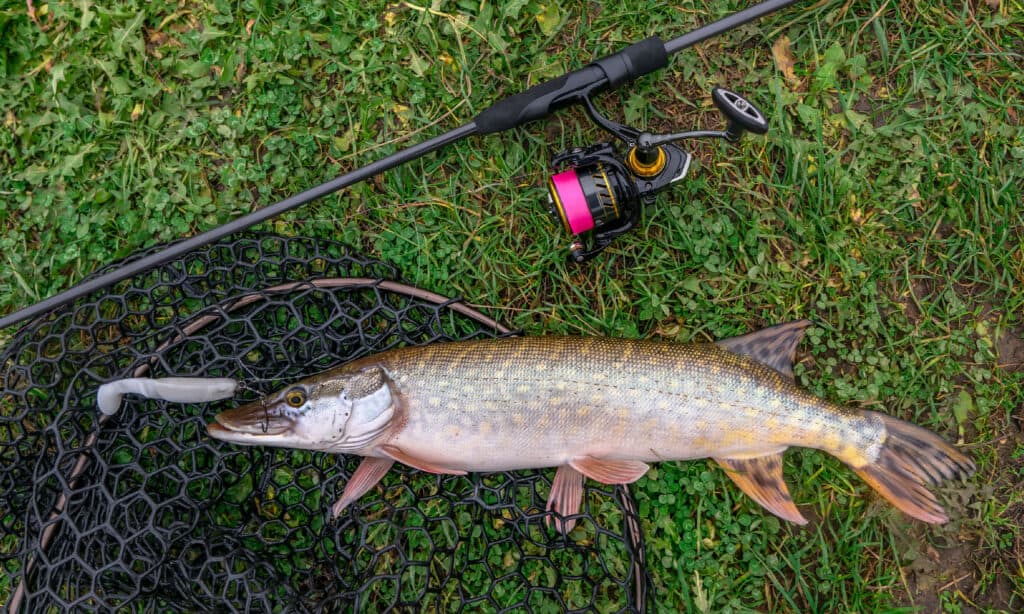
In some areas of the country, muskies cannot be released back into the water when caught because they are dangerous to smaller fish populations.
©iStock.com/FedBul
Musky, also known as Muski or Muskellunge, is a predatory fish. As part of the pike family, its name comes from the Ojibwe words meaning “great fish.” It is also easy to mistake it for an American pickerel because it behaves and looks the same. Like other ambush predators, it has a long body but a flat head, and some weigh as much as 70 lbs. Many anglers seek out these larger catches as their trophy when they set out to fish.
With a brown, green, or silver body, these fish sometimes have no other markings to differentiate them. Some anglers swear by counting their sensory pores since muskies have 7 more. On the other hand, Northern pikes never exceed 6 sensory pores beneath its mandible.
The largest musky catch in Delaware was 22.3 lbs, caught by Stephen Rutkowski in 2023. However, the largest fish ever caught was in Wisconsin, weighing over 67 lbs.
Largest White Perch: 2.6 lbs

The white perch technically isn’t a perch at all; it is a bass!
©Jennifer White Maxwell/Shutterstock.com
The white perch is aptly named for its silvery-white appearance, though darker regions with high populations recently developed darker edges near the dorsal fin. Weighing as much as almost 5 lbs. in some cases, they come in a wide range of sizes. While these fish prefer to live in brackish waters, freshwater areas are just as welcoming. Some fish swim as far east as Nova Scotia, decording the lower Great Lakes.
The largest white perch on record in Delaware was 2.6 lbs. Wayne Hastings caught this game fish in 1997, and locals still haven’t beaten his record.
Largest Yellow Perch: 2.7 lbs

The yellow perch goes by many names, including the raccoon, American, and striped perch.
©RLS Photo/Shutterstock.com
Yellow perch are a sport fish. Their fine flavor appeals to recreational and commercial fishermen alike, and finding them at any restaurant nearby is easy. Their habit of feeding together is great news for anyone who wants to catch a lot of yellow perch in one session. With so many other fish nearby, most fishermen catch yellow perch as a happy accident rather than intentionally seeking them out.
Swimming exclusively in freshwater areas of North America, yellow perch live up to 10 years with the right nourishment. However, they stay rather small. The best way to catch one of these fish is with live bait, like worms or crickets.
The largest yellow perch ever caught in Delaware weighed 2.7 lbs, caught by Marvin Kessinger in 1976. However, the world record for the largest yellow perch is 4.2 lbs, caught by Dr. C. Abbott in 1865 in New Jersey.
Largest Chain Pickerel: 7.8 lbs

Chain pickerels are only found in freshwater areas and quickly go after flashy lures.
©iStock.com/LaSalle-Photo
The chain pickerel has a distinct pattern along its sides, as well as a dark mark under its eye. This specific marking is how you tell the difference between chain pickerel and redfin pickerel. The shape of the body looks much like a northern pike, but it has scaled cheeks. With a slimy texture along its body, experienced anglers might still struggle to hold onto them.
Once you hook a chain pickerel, it doesn’t go down without a fight. Most anglers fish with live minnows, flies, spoons, lures, and other interactive accessories to catch their attention. If you use a lure, you don’t need anything special. Any bass lure appeals to them, but you need a steel leader to catch any active chain pickerel.
In 2022, William Mack set the record for the largest chain pickerel ever caught in Delaware. His catch weighed 7.8 lbs, nearly twice the average size that most fishermen catch.
Largest American Shad: 6.8 lbs
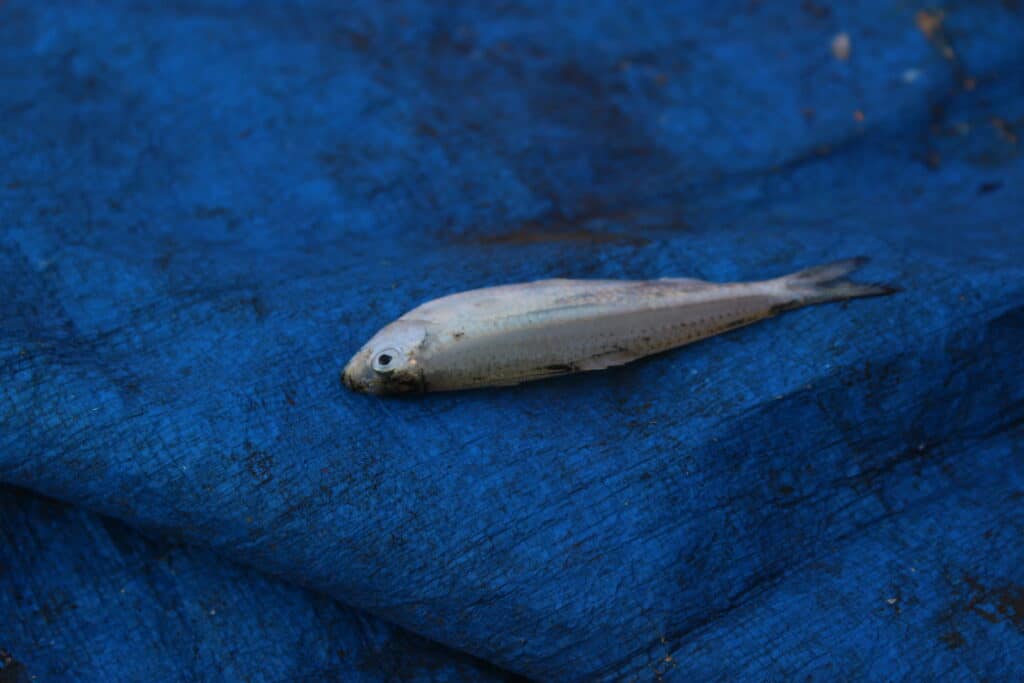
The American shad isn’t related to any other North American shad.
©Radhe Modi/Shutterstock.com
The American shad swims up and down the North American coast, though it was also introduced on the North Pacific coast. Though it shares the name with other shades, it isn’t genetically related. Instead, scientists trace it back to European fish species. In the 1680s, William Penn had to negotiate with the Lenape tribe for permission to fish for shade.
Weighing between 3 and 8 lbs., most people enjoy dining on the American shad because of its subtle taste when cooked properly. Most people don’t even add a sauce or spices, though Penn once remarked that they taste good when smoked or pickled. As sport fish, many fishermen benefit from these catches. Locals host the annual Shad Festival along the Delaware River in Lambertville, NJ.
In 1972, Bayard Conaway caught the largest American shad ever retained in Delaware. It weighed 6.8 lbs.
Largest Snakehead: 12.8 lbs

As a predatory fish, the snakehead eats plankton, aquatic insects, and mollusks.
©bigjom jom/Shutterstock.com
Snakeheads typically live in Africa and Asia, but the release of these fish by aquarium owners made them intentionally endemic to the United States. They have long dorsal fins with large mouths, but their sharp and shiny teeth are the biggest surprise. The scariest part of this fish is that it doesn’t have to stay in the water if it doesn’t want to. With the ability to breathe air through their mouths, these fish can survive for a short distance.
The largest snakehead caught in Delaware weighed 12.8 lbs, and Bobby Smith caught it in 2017.
Largest Redear Sunfish: 3.1 lbs
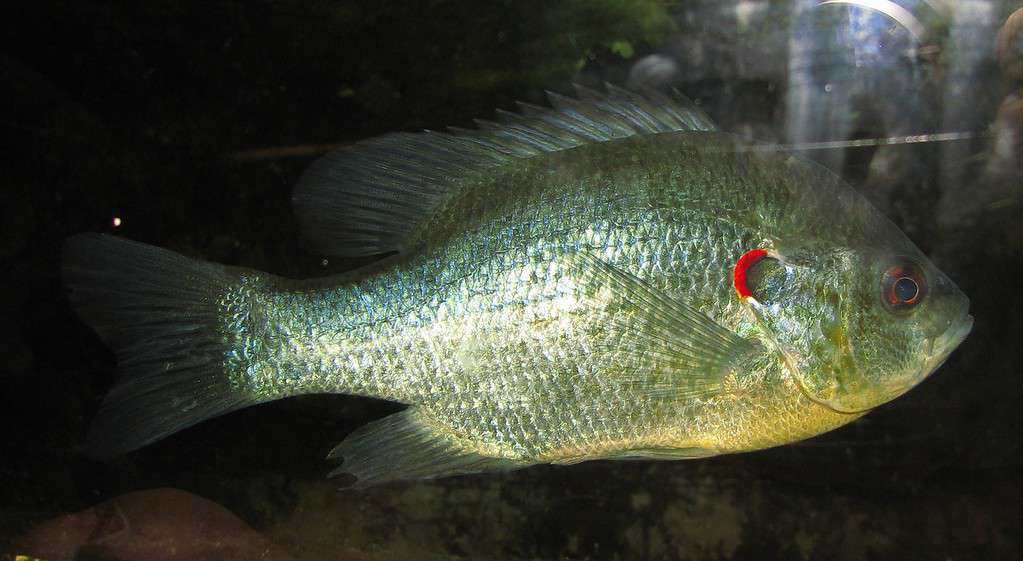
Redear sunfish are often mistaken for bluegill fish but are slightly bigger.
©Ltshears / Public domain – License
The redear sunfish goes by many names, including the shellcracker, Georgia bream, cherry gill, and sun perch. It prefers freshwater, though its natural habitat is in the southeastern United States. With classification as a sport fish, they’ve been distributed across the entire country. This fish is a carnivore, typically eating a diet of shellfish and mollusks.
With a similar appearance to bluegill, the redear sunfish is slightly larger. The vertical bars along its dorsal fin and the red edge on its operculum make it stand out. Females have orange edges instead.
The most common place to find redear sunfish isn’t in Delaware but in southeastern states like Florida and North Carolina. They are even found as far as the Rio Grande drainage in Texas. Since fisheries keep distributing them outside of their native region, their nationwide population continues to grow. They prefer warm and quiet bodies of water, grouping. This need to be close with others in their species is great news for any fisherman who catches one because there are more to come.
The largest redear sunfish ever caught in Delaware was 3.1 lbs by Marty Messick in 1998. Most redear sunfish barely weigh a pound.
Largest Trout: 11.6 lbs

Trout feels drawn to lure fishing because they are naturally predatory. Using a lure or live bait makes drawing close and catching them easier.
©Henrik A. Jonsson/Shutterstock.com
Trout is a broad term for many fish species. While it sometimes refers to some non-salmonid fish with similar shapes, they are genetically different. They migrate with the seasons, primarily to freshwater areas like lakes and rivers. Juveniles primarily stay upstream for several years until they reach full maturity. With so many different varieties of trout, the average weight varies greatly.
Catching some trout depends on where you fish. They require freshwater sources, which makes lakes and rivers among the best places to look. Creek fishermen appreciate the muscled fight they get when reeling in their catch, which requires the support of a good lure.
The largest trout caught in Delaware was over 11 pounds, caught by Edwin Wallace in 1997. However, the largest trout ever caught in the world was a lake trout weighing 72 lbs. Lloyd Bull caught this fish in Great Bear Lake in Canada.
Largest Fish Ever Caught in Delaware
| Type of Fish | Weight | Year Caught | Name of fisher |
| Striped Bass | 13.8 lbs | 1990 | Earl Blevins |
| Largemouth Bass | 11.1 lbs | 2016 | Andrew Klein |
| Smallmouth Bass | 4.9 lbs | 1989 | Jerry Porffitt |
| Bluegill | 2.6 lbs | 1998 | Arnold Harmon |
| Carp | 45 lbs | 1976 | Ronald Burnett |
| Blue Catfish | 48.5 lbs | 2023 | Chris Andrews |
| Channel Catfish | 23.4 lbs | 1992 | William Ridgley |
| Crappie | 4.6 lbs | 1976 | Marvin Billips |
| Musky | 22.3 lbs | 2023 | Stephen Rutkowski |
| White Perch | 2.6 lbs | 1997 | Wayne Hastings |
| Yellow Perch | 2.7 lbs | 1976 | Marvin Kessinger |
| Chain Pickerel | 7.8 lbs | 2022 | William Mack |
| American Shad | 6.8 lbs | 1972 | Bayard Conaway |
| Snakehead | 12.8 lbs | 2017 | Bobby Smith |
| Redear Sunfish | 3.1 lbs | 1998 | Marty Messick |
| Trout | 11.6 lbs | 1997 | Edwin Wallace |
The photo featured at the top of this post is © Tfreeman_Films/Shutterstock.com
Thank you for reading! Have some feedback for us? Contact the AZ Animals editorial team.






